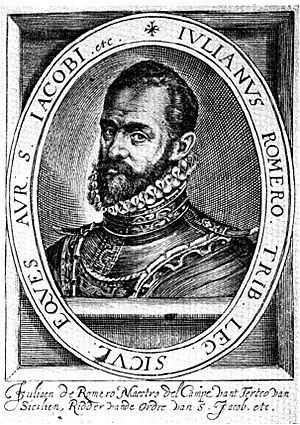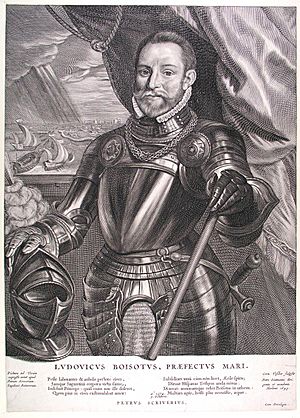Battle of the Scheldt (1574) facts for kids
Quick facts for kids Battle of the Scheldt (1574) |
|||||||
|---|---|---|---|---|---|---|---|
| Part of the Eighty Years' War | |||||||
 Battle in the Eastern Scheldt between the Spanish and the beggar fleet as portrayed by Frans Hogenberg |
|||||||
|
|||||||
| Belligerents | |||||||
| Commanders and leaders | |||||||
| Strength | |||||||
| 64 ships | 75 ships | ||||||
| Casualties and losses | |||||||
| 300 killed or wounded 2 ships sunk |
15 ships sunk 1200 dead |
||||||
The Battle of the Scheldt, also called the Battle of Walcheren, was a big naval fight. It happened on January 29, 1574. This battle was part of the Eighty Years' War and the Anglo–Spanish War.
The fight was between Dutch rebels, known as the Sea Beggars, and the Spanish fleet. The Sea Beggars were led by Lodewijk van Boisot. Their fleet also had soldiers from England and Scotland. The Spanish fleet was led by Julián Romero.
The Spanish were trying to help the town of Middelburg. This town was held by the Spanish and was under attack. But Boisot's fleet stopped them. The Dutch and English won, sinking or capturing about fifteen Spanish ships. Because of this defeat, Middelburg surrendered just nine days later. The town of Arnemuiden also gave up.
Why the Battle Happened
In April 1572, several Dutch cities joined the Dutch prince. These cities included Flushing, Veere, and Arnemuiden. They were all on the island of Walcheren. However, Middelburg, another city on Walcheren, stayed loyal to King Philip II of Spain.
Because Middelburg was loyal to Spain, the Dutch rebels began to attack it. This attack was called a siege. After many months, the Spanish soldiers in Middelburg started to run out of food and supplies. The Spanish commander, Sancho d'Avila, tried to send supplies by sea. His first attempt failed. A third attempt was stopped when Dutch and English forces captured Fort Rammekens in August 1573.
Lodewijk van Boisot, who was the Admiral of Zeeland, wanted to fight the Spanish fleet. He joined up with another Dutch fleet led by Vice Admiral Joos de Moor. They also picked up more soldiers, including English and Scottish companies. These troops were led by Colonel Thomas Morgan. Their goal was to find and fight the Spanish fleet.
Don Luis de Requesens y Zúñiga, the Spanish commander, decided to send a strong naval force. He wanted to destroy the Dutch rebels for good. He also hoped to rescue the Spanish soldiers stuck in Middelburg. He ordered Don Julian di Romero and a Flemish admiral, Gerard de Glymes, to sail to Walcheren. This area was in the Scheldt estuary, where the Sea Beggars were active.
Don Julian di Romero was a good leader on land. But he didn't have much experience with ships. He told Zúñiga this many times, but Zúñiga didn't listen. The Spanish fleet, carrying many supplies, had already started sailing. But it had not gone farther than Bergen op Zoom. Zúñiga was worried about the fleet. He went with it as far as the Scheldt estuary.
The Battle Begins
On January 29, the Spanish ships stopped and waited for the tide to rise. Then they sailed from Bergen. They fired a salute for their commander. But one ship's gun accidentally set fire to its own gunpowder storage. The ship exploded, killing everyone on board. This made the Spanish sailors feel very sad and worried.
The fleet slowly continued sailing. When they were near Reimerswaal, off Walcheren, they saw a large group of ships. The Spanish thought these were friendly ships and sailed closer. But they soon realized it was the fleet of Lodewijk van Boisot, the Dutch Admiral. They tried to turn away as the weather got worse. But it was too late. They had to get ready for battle. Boisot ordered his fleet to attack. Both fleets lined up to fight in the Scheldt estuary.

Romero's first group of ships came closer. They fired their cannons first. During this attack, two Dutch officers, Schot and Klaafzoon, were badly wounded and died. Admiral Boisot lost an eye. Many other officers and sailors on the Dutch ships were also killed or hurt. The soldiers who were supposed to help with the siege were used heavily in the fight. This surprised the Spanish.
The Dutch ships were able to get very close to the Spanish ships. The soldiers then boarded the Spanish vessels one by one. Many of Romero's ships were caught in the narrow estuary. Soon, they were locked in close combat. A terrible hand-to-hand fight began.
Hand-to-Hand Combat
The battle lasted for two hours. Finally, the Anglo-Dutch forces started to win. Admiral de Glymes's own ship got stuck on a sand bank. It could not move. The Dutch rebels saw this and attacked his ship from all sides. After taking many hits, they set it on fire.
Captain Rowland Yorke and his English soldiers moved from Vice Admiral Joos de Moor's main ship. Colonel Thomas Morgan's English company also came from another Flemish ship. Together, they boarded several Spanish ships. Romero tried to help de Glymes, but he couldn't put out the flames. De Glymes's ship sank in a few minutes, taking the Admiral with it.
A flaming mast from de Glymes's ship then set fire to Romero's ship. Morgan’s men, including the famous soldier Roger Williams, quickly boarded the burning ship. Dutch soldiers boarded from the other side. They captured the ship by taking its flag. They almost captured Julien Romero, but he managed to escape through a small window as his ship burned.
A Scottish captain named Robinson led his men and captured the Spanish Rear Admiral’s ship. The Spanish fleet was in complete chaos. They managed to escape in the bad weather. But they lost five more ships during the chase. The pursuit stopped when night fell, and the battle ended.
After the Battle
Don Louis Zúñiga watched the whole battle. He stood on top of a dyke in the pouring rain. Romero came ashore and found Zúñiga. He calmly said:
I told your excellency that I was a land fighter, not a sailor - give me a hundred fleets and I would fare no better.
– Romero
The Spanish forces retreated in disarray to Bergen. They had lost fifteen ships, which were either captured or sunk. About 1,200 Spanish soldiers were killed, wounded, or captured. The Spanish were completely defeated. The Dutch fleet, with its Anglo-Dutch soldiers, had about 300 casualties. They lost two ships that were sunk. Some ships ran aground but were later saved.
The rest of the Spanish fleet had been sailing to Flushing. When they heard about this disaster, they quickly retreated to Antwerp. Don Zúñiga said the fighting he saw was as fierce as the battle of Lepanto. He had fought in that battle only three years earlier.
Because of this victory, Middelburg surrendered just nine days later. Arnemuiden also surrendered. These two wins meant the Dutch rebels now controlled the main islands of Zeeland. They also became masters of the local seas.
In September, the victorious Anglo-Dutch ships and sailors brought much-needed help to Leiden. Leiden had been under siege by the Spanish since 1572.
King Philip II was very angry about these defeats. He decided to send a large force to the North Sea. He wanted to destroy the English and Sea Beggar fleets. But within a year, sickness, poor planning, and the death of their commander Pedro Menéndez de Avilés destroyed this force. It was no longer a threat.
See also
 In Spanish: Batalla de Reimerswaal para niños
In Spanish: Batalla de Reimerswaal para niños



